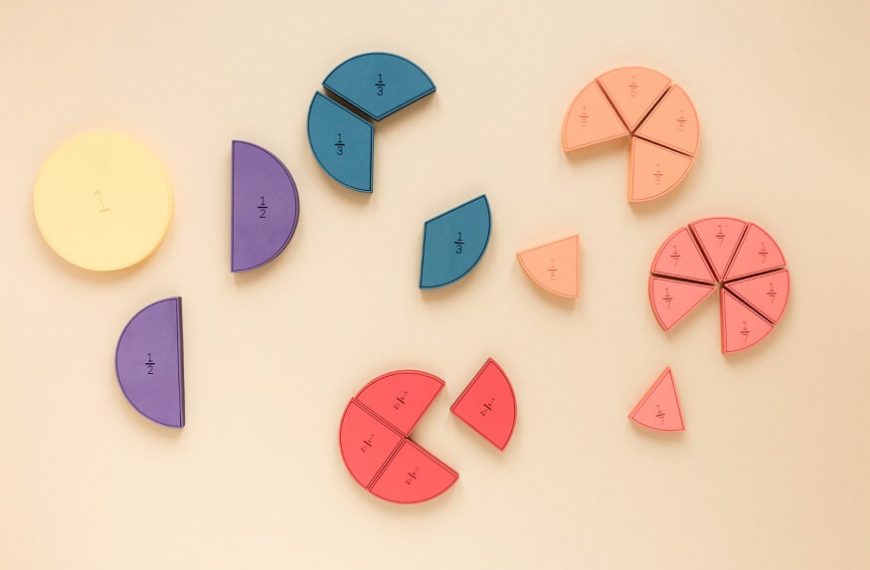Exploring the Essence of Division: Characteristics, Examples, and Applications
Fractions are an integral part of mathematics, yet many students and even adults struggle to grasp their concepts fully. In this big article, we’re going to talk about fractions. So when we finish reading, you’ll be a fractions pro and ready to do maths with them!
What is a Fraction?
Fractions are a bit like having a pizza and only wanting to enjoy a portion of it, not the entire pie. It’s a way of indicating exactly how much of that pizza you’re interested in savouring.
The way fractions are written is with one number on top, referred to as the numerator, and another number on the bottom, which is called the denominator. For instance, if you see 1/2, that means you’re planning to savour one out of the two slices.
In essence, the numerator informs you of the quantity of parts you possess, while the denominator lets you know how many parts constitute the whole pizza. Fractions are incredibly handy when it comes to sharing or comparing quantities.
How to Understand Fractions
Understanding fractions becomes more accessible when you utilise visual aids and relate them to everyday scenarios. Visualising fractions is like looking at a delicious pizza sliced into equal portions. If you devour 3 out of slices, you can effortlessly represent this consumption as the fraction 3/. This visual representation vividly illustrates the relationship between the parts (3 slices) and the whole ( slices). Fractions are not just for school, they’re everywhere in real life too! Like when you’re making yummy food, you use fractions in recipes. You might need 1/2 cup of sugar or 3/4 teaspoon of salt. These fractions in cooking show how fractions are super useful in everyday stuff. It’s like connecting maths to real life, and that helps us understand fractions better and see how they’re important in different things we do!
Understanding Different Types of Fractions
Fractions come in various forms, each with distinct characteristics that are essential to comprehend for a comprehensive grasp of this mathematical concept.
- Proper Fractions: In proper fractions, the numerator is smaller than the denominator. For example, consider fractions like 1/3 or 2/5. These fractions represent values that are less than 1 and are often employed to describe parts of a whole. Proper fractions are akin to dividing up a pizza into slices, where you take only a portion of the whole, leaving the rest.
- Improper Fractions: Conversely, improper fractions exhibit a numerator equal to or greater than the denominator. Examples include 5/4 or 7/3. These fractions represent values exceeding 1 and frequently denote a combination of holes and parts. Improper fractions can be likened to scenarios where you not only take a portion of a whole but also have some leftover, highlighting their versatility.
- Mixed Numbers: Mixed numbers are like when you have a whole number and a little piece of another number, like 1 and a half or 3 and three-quarters. They’re super helpful when you want to show both the whole part and the part that’s not a whole, all in one. Mixed numbers are used when you need to say, “I have this whole thing, but also a little extra bit of it.” It helps to tell the whole story!
Characteristics of Fractions and Their Role in Mathematical Operations
Fractions are characterised by unique properties that significantly impact how they behave during various mathematical operations. Understanding these characteristics is crucial for confidently manipulating fractions in mathematical problem-solving.
- Equivalent Fractions: One fundamental characteristic is the existence of equivalent fractions. Equivalent fractions represent the same portion of a whole but are expressed differently. For example, 1/2 and 2/4 are equivalent because they both signify half of something. Recognizing equivalent fractions enables us to work with fractions in multiple forms while maintaining the same underlying value.
- Simplifying Fractions: Another important thing is making fractions simple. That means making them as small as they can be. To do this, we use a special number called the greatest common divisor (GCD) to help us. For example, if we have 4/8, we can make it simpler by dividing the top and bottom by 4. That gives us 1/2, which is much easier to work with. So, making fractions simpler helps us do maths better and easier!
- Adding and Subtracting Fractions: When you’re adding or taking away fractions, there’s a super important rule: they need to have the same bottom number, called the denominator. If they don’t have the same denominator, you have to make them match by finding a new number for the bottom part. This makes sure you’re putting together or comparing fractions that are all about the same-sized pieces of something whole, like a pizza!
Fraction Numbers in Real-Life Scenarios
- Cooking Measurements: Picture yourself in the kitchen, ready to bake a delicious cake. The recipe calls for 3/4 cup of flour. This fraction, 3/4, represents three-quarters of the required amount. It’s like a culinary magic trick, where you’re turning a whole cup of flour into a precise portion, ensuring your cake turns out just right.
- Sharing Pizza: Imagine a delightful evening with friends, and you’ve ordered a pizza with 8 slices. As you savour 2 slices, you’ve consumed 2/8 of the pizza, which simplifies neatly to 1/4. Fractional maths on your pizza night ensures that everyone gets their fair share, making fractions a handy tool for dividing delicious treats.
- Time Management: Now, consider managing your time effectively. If you allocate 2/5 of an hour to studying and the remaining time to relaxation, you’ve divided your precious hour into fifths, reserving 2 of them for focused study. Fractions here are your allies in time management, allowing you to allocate your resources efficiently.
These real-life examples showcase how fractions are not just abstract mathematical concepts; they are tools that empower you to make precise measurements, share experiences, and optimise your time.
Fractions help us share pizza, bake perfect cakes, and manage our time efficiently. By grasping the visual and practical aspects of fractions, and by knowing their types and characteristics, you can conquer this essential skill.
So, dive into the world of fractions with confidence and empower yourself with the tools to navigate both maths challenges and daily life. If you’re looking to give your child a head start in mathematics, consider EuroKids, where top-notch education meets real-world applications. Contact us today to open the doors to a brighter future.
















